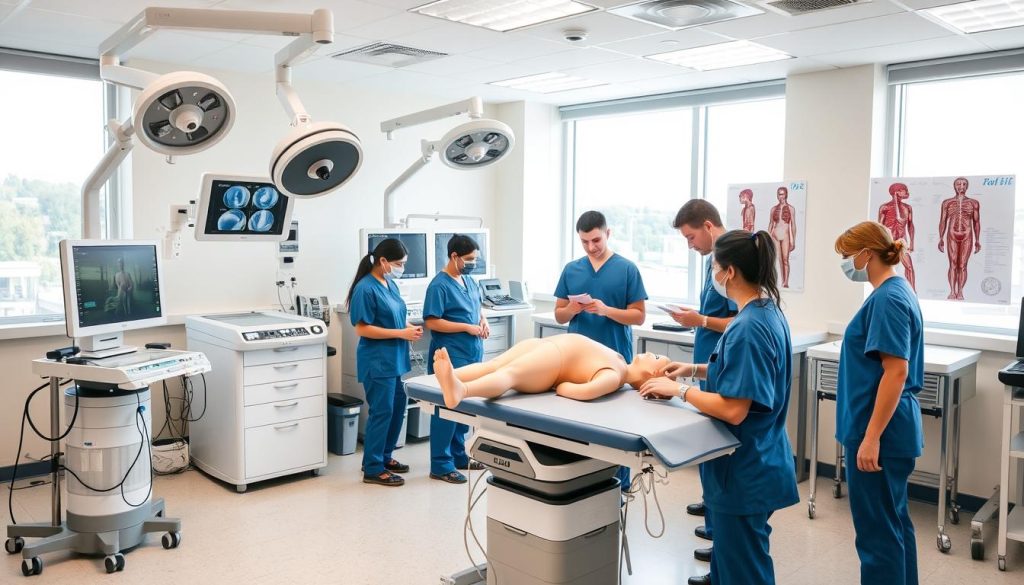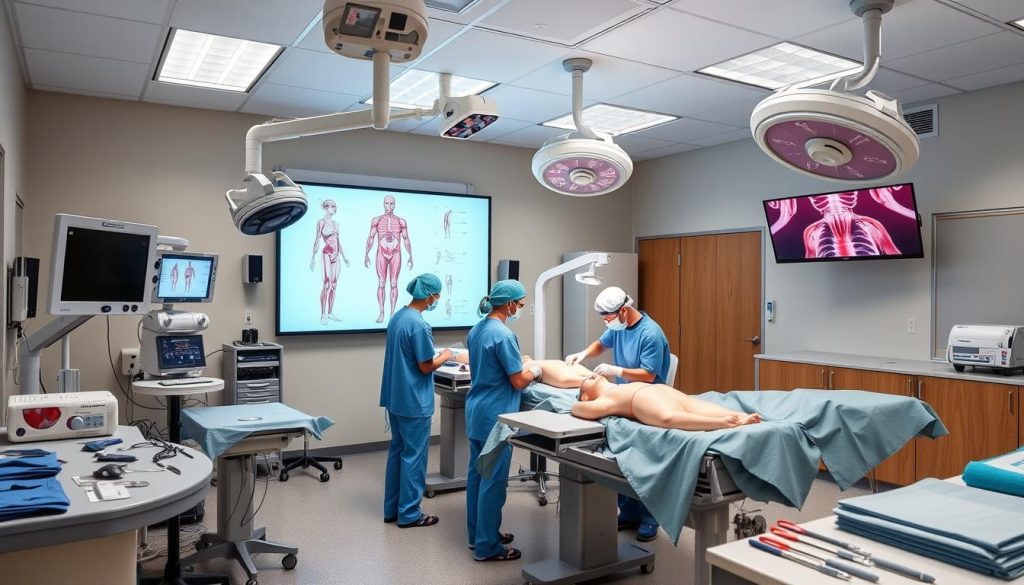Becoming a certified surgical technologist (CST) is a great choice for those in the medical field. Surgical technologists are key in the operating room, ensuring safety and efficiency. To start this career, you need to finish an accredited program, which takes 1-2 years.
In this guide, we’ll look at what surgical technologists do, how to become one, and the best programs in the U.S. This guide is for those starting in healthcare or looking to grow their skills. It will help you decide if a surgical tech career is right for you.
Key Takeaways:
- Surgical tech programs usually take 1-2 years to finish and need specific requirements and a good GPA.
- The median salary for surgical technologists is $56,350, or $27.09 an hour, says the Bureau of Labor Statistics (BLS).
- Accredited programs include about 500 hours of clinical internship for real-world experience.
- Being a Certified Surgical Technologist (CST) is highly valued by employers and can open more doors.
- The field of surgical tech is expected to grow, making it a promising career choice.
Understanding the Role of a Surgical Technologist
Surgical technologists, also known as operating room technicians or surgical assistants, are key in healthcare. They work with surgeons, anesthesiologists, and nurses to ensure surgeries go smoothly. They prepare the room and help during surgery, making sure patients are safe and have good outcomes.
Key Responsibilities in the Operating Room
Surgical technologists do many things in the operating room. Their tasks include:
- Sterilizing and preparing surgical instruments and equipment
- Ensuring a sterile environment by setting up the operating room and maintaining strict infection control protocols
- Passing instruments, sutures, and other necessary items to the surgical team during procedures
- Assisting the surgeon by providing an extra set of hands, such as holding retractors or suctioning the surgical site
- Dressing wounds and applying sterile bandages following the completion of a surgical procedure
- Maintaining a detailed inventory of surgical supplies and instruments
Career Growth and Advancement Opportunities
The field of operating room technician training offers many chances for growth. Technologists can specialize in areas like cardiology or orthopedics. They can also move into leadership roles, such as supervisor or manager.
Working Environment and Conditions
Surgical technologists work in hospitals, surgery centers, and doctors’ offices. Their job is fast-paced and requires focus on detail. They often work long hours, including nights and weekends, and may have on-call duties.
The surgical assistant certification and ongoing education are crucial. They help technologists keep up with new medical technology and techniques. This ensures they can give the best care to patients and support the surgical team.
Surgical Tech Programs: Requirements and Prerequisites
To get into a surgical technology degree program, you need to meet certain requirements. You must have a high school diploma or GED. You also need to be a U.S. citizen or permanent resident and be at least 18 years old.
Most programs ask for specific courses like human anatomy and medical terminology. You need to have a good GPA to show you’re ready for the challenge. You might also need to pass background checks and provide health records.
Some programs require you to take placement tests in reading, English, and math. This checks if you’re ready for the tough classes and clinical training ahead.
The requirements for a surgical technology degree are set to find the right candidates. They look for people with the right knowledge, skills, and qualities for this demanding yet rewarding allied health education field.

“Surgical technology programs seek to cultivate well-rounded individuals who are passionate about delivering exceptional patient care in the dynamic operating room environment.”
Educational Pathways to Become a Surgical Technologist
There are many ways to start a career as a surgical technologist. You can choose from certificate programs, associate degrees, or diploma courses. Each option has its own benefits and prepares you for the role of a surgical technologist.
Certificate Programs
Certificate programs in surgical technology last from 9 to 15 months. They focus on giving students the essential skills and knowledge for the operating room. These programs offer a lot of hands-on training, helping you feel confident and skilled in assisting surgeons.
Associate Degree Options
Associate degree programs in surgical technology are a great choice for a deeper education. They take two years to complete and cover a wide range of topics. You’ll learn about anatomy, medical terms, patient care, and advanced surgical techniques. This education can give you an advantage in finding a job, as you’ll understand the healthcare industry better.
Diploma Programs
Diploma programs in surgical technology are a middle ground between certificate and associate degree programs. They last from 12 to 18 months and provide a solid foundation in the necessary skills and knowledge. These programs aim to balance technical skills with a deeper understanding of the medical field.
Choosing any of these educational paths can lead to a fulfilling career in healthcare. With the right training and certification, you’ll be an important part of ensuring good outcomes for patients during surgeries.
| Program Type | Duration | Focus | Advantages |
|---|---|---|---|
| Certificate Programs | 9-15 months | Core skills and knowledge for the operating room | Intensive, hands-on training |
| Associate Degree Programs | 2 years | Comprehensive education in surgical technology and healthcare | Broader understanding of the medical field |
| Diploma Programs | 12-18 months | Balanced approach to technical and theoretical knowledge | Flexible duration and curriculum |
“Surgical technologists play a vital role in ensuring the success of surgical procedures by providing a sterile, organized, and efficient environment for the surgical team.”
Top-Rated Surgical Tech Schools in the United States
There are many top programs in the U.S. for training surgical technologists. These schools offer great curriculums, lots of hands-on training, and a strong track record of success. They prepare students well for the operating room.
Indiana University Health in Indianapolis is a great example. It has a pass rate of over 90% on the Certified Surgical Technologist exam. The program mixes classroom learning with clinical rotations. This gives students the skills they need to succeed.
The University of Arkansas – Pulaski Tech in North Little Rock is also highly regarded. It not only prepares students for the CST exam but also teaches teamwork and critical thinking. These skills are crucial in the fast-paced operating room.
- University of Cincinnati – Clermont College in Batavia, Ohio, offers a surgical tech program with a 100% placement rate for its graduates.
- Gateway Community College in New Haven, Connecticut, has been recognized for its exceptional surgical technology curriculum and student outcomes.
- Rochester Community and Technical College in Minnesota has a long-standing reputation for producing well-trained surgical technologists.
- NYU Langone in New York City is renowned for its state-of-the-art facilities and hands-on training that prepares students for the rigors of the surgical field.
- The University of Pittsburgh – Johnstown in Pennsylvania boasts a surgical tech program with a 100% pass rate on the CST exam.
These top schools in the U.S. offer a surgical technology degree and the skills needed for operating room technician training. They focus on quality education and clinical experiences. This helps shape the future of surgical technology.
| School | Program Highlights | Student Outcomes |
|---|---|---|
| Indiana University Health | Rigorous curriculum and hands-on training | 90%+ CST exam pass rate |
| University of Arkansas – Pulaski Tech | Emphasis on teamwork and critical thinking | Exceptional preparation for operating room roles |
| University of Cincinnati – Clermont College | 100% placement rate for graduates | Highly skilled and job-ready surgical technologists |
“The surgical tech program at Gateway Community College provided me with the hands-on training and clinical experience I needed to feel confident in the operating room. The instructors were extremely knowledgeable and dedicated to our success.”
– Sarah, Graduate of Gateway Community College Surgical Tech Program
Program Costs and Financial Aid Options
Starting a career in surgical tech means investing in your education. But, there are many ways to make it more affordable. The cost of these programs can vary, from $4,000 for online courses to $25,000 for more in-depth programs.
Tuition and Additional Expenses
Certificate programs, like Indiana University Health’s at $4,200, are generally cheaper. But, programs like Lassell University’s $23,040 certificate are also available. Associate degree programs, like Berkley College’s, can cost up to $38,000.
Students also need to think about extra costs. This includes textbooks, uniforms, and exam fees. The CST and TS-C exams cost $190 and $199, respectively.
Scholarship Opportunities
There are many scholarships for those interested in surgical tech. The Pell Grant is a federal program that doesn’t need to be paid back. The Federal Supplemental Education Opportunity Grant (FSEOG) helps students with the greatest need.
Many states also offer grants and scholarships for healthcare careers, including surgical tech.
Federal Aid Programs
Students can also look into federal aid like student loans. There are loan repayment and forgiveness programs for those who work in this field. With the right planning, the cost of a surgical tech education can be manageable.
Clinical Training and Hands-on Experience
To become a skilled surgical technologist, you need lots of hands-on training and real-world experience. Programs like the one at American Career College offer over 1,000 hours of supervised practice. This training happens in hospitals, surgical centers, and mock labs, where students can use what they learned in class.
These programs let you work with experienced healthcare pros. You’ll see different surgeries and learn key skills for the operating room. You’ll learn to sterilize tools and help with complex surgeries. This experience is crucial for getting your surgical assistant certification and doing well in your career.
Some programs, like American Career College’s, also have on-campus mock surgery labs. These labs let students practice in a safe space. It helps them get better and more confident before they start real clinical rotations.
“The clinical training was the most valuable part of my surgical tech program. It gave me the chance to apply what I learned in the classroom and develop the essential skills I needed to thrive in the operating room.”
By choosing a program that focuses on hands-on training, you’ll be ready to excel as a surgical assistant. You’ll make a big difference in the healthcare world.

Certification and Licensing Requirements
Becoming a certified surgical technologist is key to a fulfilling career in healthcare. While not all states require it, many employers want their staff to be certified. The most common is the Certified Surgical Technologist (CST) exam, given by the National Board of Surgical Technology and Surgical Assisting (NBSTSA).
National Board Examination Process
To take the CST exam, you need to graduate from a CAAHEP or ABHES accredited program. The exam tests your knowledge and skills in surgical technology. This ensures you’re ready to perform well in the operating room.
State-Specific Requirements
- Some states, like Idaho, Nevada, New York, Texas, and Virginia, have extra licensing or registration for surgical technologists.
- States such as California, Georgia, Hawaii, Indiana, Kansas, Louisiana, Michigan, and Pennsylvania don’t require any certification or licensing.
- Places like Colorado, North Dakota, and Washington have their own rules that surgical technologists must follow.
Future surgical assistants should check their state’s specific requirements. This ensures they meet all qualifications and follow local laws.
The journey to becoming a certified surgical technologist varies by location. Yet, the hard work and dedication needed to succeed in this field are constant. By getting the right credentials and keeping up with industry standards, surgical techs can thrive in the surgical assistant certification and healthcare career programs.
Salary Expectations and Job Outlook
Exploring the healthcare field, I find the salary and job outlook for surgical technologists encouraging. The U.S. Bureau of Labor Statistics reports a median annual wage of $56,350 in 2022. It also notes a 5% growth from 2022 to 2032, outpacing the average for all jobs.
The aging population and medical technology advancements drive this growth. These factors increase the need for surgical procedures. Surgical technologists in hospitals often earn more than those in private offices. With proper training and certification, I could secure a good salary and a fulfilling career.
The salary for surgical technologists varies by experience, location, and specialization. For example, Alaska’s average is $73,960, while California’s is $72,860. Getting certified, like the Certified Surgical Technologist (CST) credential, can also increase my earnings.
FAQ
What is the role of a surgical technologist?
What are the educational requirements to become a surgical technologist?
What are the different educational pathways to become a surgical technologist?
What are some of the top-rated surgical tech schools in the United States?
What are the typical costs and financial aid options for surgical tech programs?
What is the importance of clinical training and hands-on experience for surgical technologists?
What are the certification and licensing requirements for surgical technologists?
What is the job outlook and earning potential for surgical technologists?
Source Links
- Top 10 Surgical Technologist Programs – https://nurse.org/healthcare/surgical-tech-programs/
- How to Become a Surgical Technologist in California | ACC – https://americancareercollege.edu/guides/how-to-become-a-surgical-technologist-in-california
- How to Become a Surgical Technologist in California: Surgery Technology Career Guide – https://www.sjvc.edu/guides/guide-on-surgical-technology/
- Surgical Technologist – Explore Health Care Careers – Mayo Clinic College of Medicine & Science – https://college.mayo.edu/academics/explore-health-care-careers/careers-a-z/surgical-technologist/
- Surgical Technologist vs Surgical Technician: What’s the Difference? | Health Tech Academy – https://www.healthtechacademy.org/surgical-technologist/surgical-technologist-vs-surgical-technician
- Surgical Technology (A.A.S. Degree) | Program Requirements – https://www.monroecc.edu/etsdbs/mccatpub.nsf/hegis codes/Surgical Technology (AAS DEGREE)?OpenDocument
- Get Started | Healthcare Programs – https://healthcare.seattlecentral.edu/programs/surgical-technology/get-started
- Surgical Technology – https://www.swccd.edu/programs-and-academics/career-education/health/surgical-technology/index.aspx
- Surgical Technology Program | NYU Langone Health – https://med.nyu.edu/education/other-educational-programs/surgical-technology-program
- How to Become a Surgical Technologist | All Allied Health Schools – https://www.allalliedhealthschools.com/surgical-technologist/
- 2025 Best Surgical Technology Schools – https://www.collegefactual.com/majors/health-care-professions/allied-health-professions/surgical-technology-technologist/rankings/top-ranked/
- Best Surgical Tech Programs For A Career In Healthcare Of 2024 – https://www.accreditedschoolsonline.org/healthcare/surgical-technician/
- Surgical Technology | Associate of Applied Science Degree (A.A.S.) – https://www.pct.edu/academics/nhs/surgical-technology/surgical-technology
- Cost to Become a Surgical Tech (Programs & Certification) – https://www.stepful.com/post/cost-to-become-a-surgical-tech
- Funding Surgical Tech Education: Grants and Loans – CNI College – https://cnicollege.edu/blog/student-services/pay-surgical-tech-programs-federal-financial-aid/
- How to Become a Surgical Tech (with Steps) – https://www.carerev.com/blog/how-to-become-a-surgical-tech
- Tech in Surgery – https://altamonthealthcare.com/programs/surgical-tech/
- Surgical Tech Online School: Online vs Hybrid Courses – CBD College – https://www.cbd.edu/blog/surgical-tech-online-school-online-vs-hybrid-courses/
- How To Become a Surgical Tech – https://www.concorde.edu/blog/how-to-become-a-surgical-tech
- PDF – https://www.chcp.edu/assets/pdf/Surgical Technology State Licensure Requirements_v2_2020.11.03a.pdf
- How to Become a Surgical Technologist – https://nurse.org/healthcare/how-to-become-surgical-technologist/
- Surgical Tech Career Outlook: Promising Future & Job Security – https://www.hctravelnursing.com/blog/surgical-tech-career-outlook
- Surgical Technician Salary Guide (2023) | Trusted Health – https://www.trustedhealth.com/allied-career-guide/surgical-tech/salary-guide
- Surgical Tech Salary Guide for 2023: Earning Potential and Job Outlook – https://www.hiration.com/blog/surgical-tech-salary/


